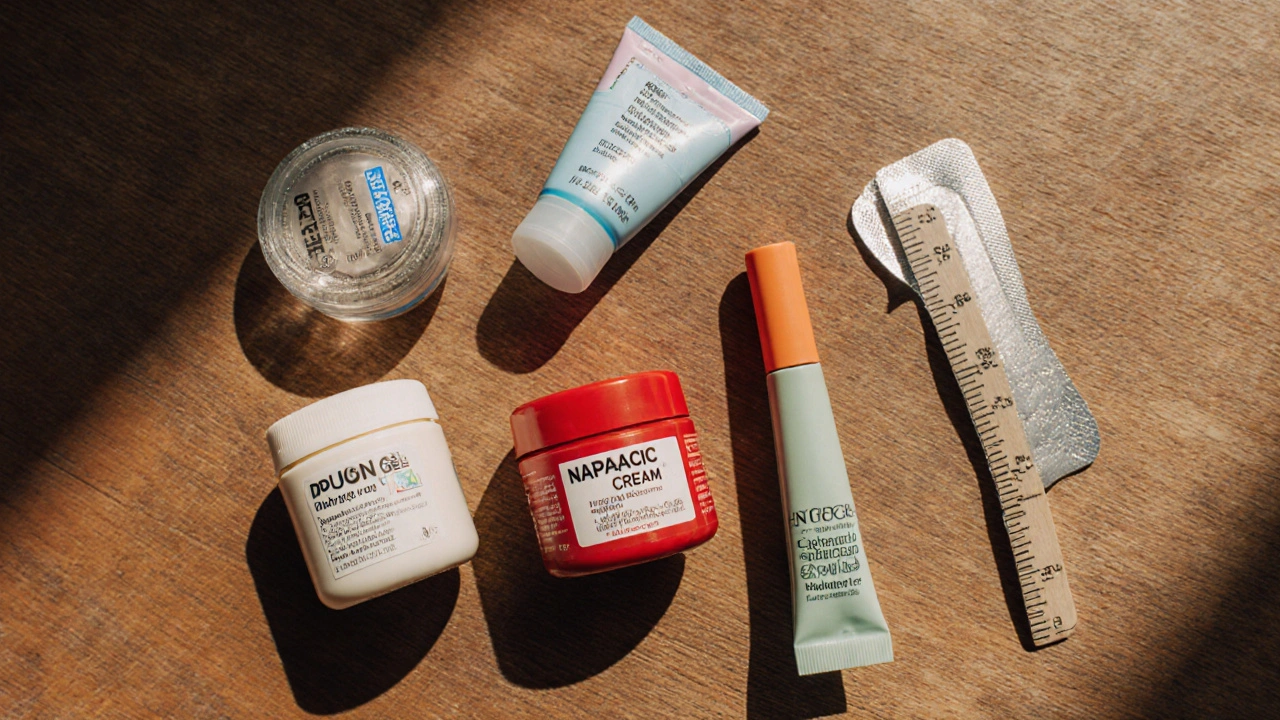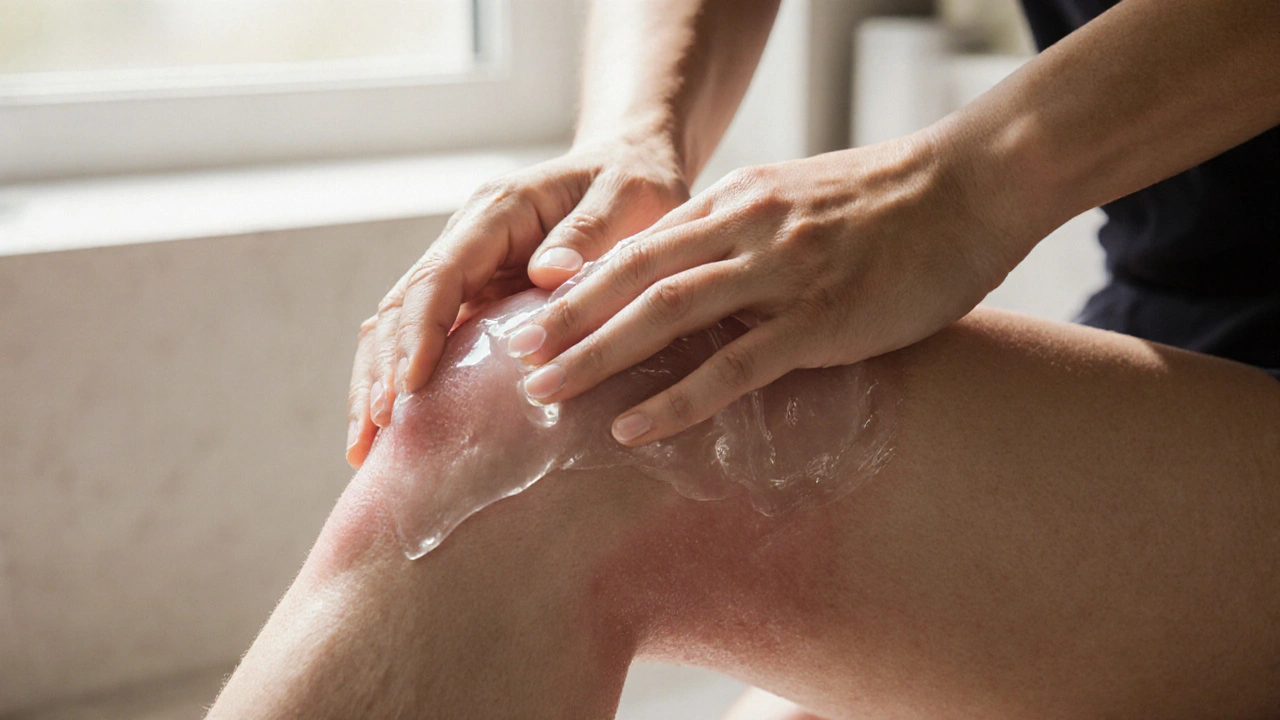Topical Pain Reliever Selector
Recommended Topical Pain Reliever
Diclofenac Gel
NSAID Effective for inflammatory pain with quick onset (30-60 min). May cause skin irritation.
Ibuprofen Gel
NSAID Milder NSAID, good for sensitive skin. Slower onset (45-90 min).
Naproxen Cream
NSAID Long-lasting (up to 12 hrs) but may feel greasy.
Capsaicin Cream
Capsaicin Works on nerve pain. Initial burning sensation, but effective for chronic pain.
Menthol/Camphor Rub
Cooling Agent Provides temporary relief for muscle soreness. Does not reduce inflammation.
Lidocaine Patch
Local Anesthetic Good for localized nerve pain. Long-lasting numbing effect (up to 12 hrs).
Quick Summary / Key Takeaways
- Diclofenac gel is a topical NSAID that works well for joint and muscle pain but can cause skin irritation.
- Ibuprofen gel and naproxen cream offer similar anti‑inflammatory effects with slightly different skin tolerability.
- Capsaicin cream, menthol rubs, and lidocaine patches relieve pain through nerve desensitisation rather than inflammation control.
- Cost, onset time, and side‑effect profile are the main factors when picking a gel or cream.
- In Australia 2025, most gels are available over‑the‑counter, but a pharmacist’s advice is still useful for chronic conditions.
What Is Diclofenac Gel?
When you need fast relief for an achy knee, sore elbow, or a pulled muscle, diclofenac gel is often the first thing pharmacists recommend. It is a topical non‑steroidal anti‑inflammatory drug (NSAID) that comes in a gel or cream form. The gel typically contains 1% or 2% diclofenac sodium, which is the same active ingredient found in many oral pain tablets, but it’s applied directly to the skin over the painful area.
How Diclofenac Gel Works
Diclofenac belongs to the NSAID family, which means it blocks the cyclooxygenase (COX) enzymes that produce prostaglandins - the chemicals that cause swelling, heat and pain in injured tissue. By inhibiting COX‑2 more than COX‑1, the gel reduces inflammation locally while keeping systemic exposure low. Because the drug stays mostly on the surface, you get a quicker onset (about 30‑60minutes) and a lower risk of stomach upset compared with oral NSAIDs.

When to Use Diclofenac Gel
Typical uses include:
- Osteoarthritis of the knee or hand
- Rheumatoid arthritis flare‑ups
- Soft‑tissue injuries such as sprains, strains, and bruises
- Post‑exercise muscle soreness
It’s not meant for deep‑seated joint pain (like hip arthritis) where the drug can’t reach the target tissue. Also, avoid using it on large open wounds, broken skin, or near the eyes.
Topical Alternatives Overview
If you’ve tried diclofenac gel and it didn’t work, or you’re looking for a different safety profile, several other over‑the‑counter options exist. Below is a quick snapshot of each.
Ibuprofen Gel
Ibuprofen gel uses the same NSAID class as diclofenac but with a slightly milder COX‑2 preference. Most Australian brands contain 5% ibuprofen. It’s popular for minor sports injuries and can be a good choice if you experience skin irritation from diclofenac.
Naproxen Cream
Naproxen is another NSAID that you’ll find in a 1% cream formulation. It tends to have a longer duration of action (up to 12hours) which can reduce the need for re‑application. However, it sometimes feels greasier on the skin.
Capsaicin Cream
Derived from chili peppers, capsaicin works by depleting SubstanceP, a neurotransmitter that sends pain signals. A 0.075% or 0.025% cream or gel is sold for arthritis and neuropathic pain. You’ll feel a warm tingling at first, but the pain often lessens after a few days of regular use.
Menthol/Camphor Rub
Menthol and camphor provide a cooling sensation that distracts the brain from pain (a process called counter‑irritation). Common brands contain 2‑4% menthol combined with camphor. They’re great for sore muscles after a run but don’t address inflammation.
Lidocaine Patch
Lidocaine is a local anaesthetic. The patch sticks to the skin and releases the drug slowly, numbing the area for up to 12hours. It’s especially useful for post‑surgical incisions or nerve pain, but it won’t reduce swelling.
Side‑by‑Side Comparison
| Product | Active Ingredient | Typical Concentration | Primary Use | Onset | Duration | Common Side Effects | Approx. Cost (AUD) |
|---|---|---|---|---|---|---|---|
| Diclofenac Gel | Diclofenac Sodium | 1%-2% | Joint & muscle inflammation | 30‑60min | 6‑8hrs | Skin irritation, rare GI upset | $12‑$18 (30g tube) |
| Ibuprofen Gel | Ibuprofen | 5% | Minor sprains, strains | 45‑90min | 6‑10hrs | Mild burning, rash | $10‑$15 (30g tube) |
| Naproxen Cream | Naproxen | 1% | Chronic joint pain | 45‑90min | 8‑12hrs | Greasy feel, dermatitis | $13‑$20 (30g tube) |
| Capsaicin Cream | Capsaicin | 0.025%‑0.075% | Neuropathic & arthritis pain | 2‑3hrs (after repeated use) | 4‑6hrs | Burning, redness | $9‑$14 (30g tube) |
| Menthol/Camphor Rub | Menthol & Camphor | 2‑4% each | Muscle soreness, tension | 5‑15min | 2‑4hrs | Cooling sensation, skin irritation | $8‑$12 (50g tube) |
| Lidocaine Patch | Lidocaine | 5% (per patch) | Localized nerve pain | 15‑30min | 6‑12hrs | Local numbness, itching | $25‑$35 (5‑patch pack) |

Choosing the Right Option
Here are the three main questions to ask yourself before reaching for a tube or patch:
- What’s causing the pain? If inflammation is the main driver (sprain, arthritis flare), an NSAID gel like diclofenac, ibuprofen or naproxen is logical. If the pain is more nerve‑related (post‑surgical scar, diabetic neuropathy), lidocaine or capsaicin may work better.
- How sensitive is your skin? People with eczema or very dry skin often report irritation with diclofenac or ibuprofen gels. Menthol rubs and low‑strength capsaicin are usually gentler.
- What’s your budget and convenience preference? Patches are pricier but need only one application per day. Creams and gels are cheaper but may need 2‑3 re‑applications.
For most Australians with occasional joint pain, starting with a 1% diclofenac gel is sensible. Keep an eye on skin reaction; if you notice redness that lasts more than a day, switch to a milder ibuprofen gel or a menthol rub.
Practical Tips & Common Pitfalls
- Apply a thin layer and rub it in gently - more product does not mean faster relief.
- Wait at least 10minutes before covering the area with clothing to avoid staining.
- Do not use more than fourgrams of any NSAID gel in a 24‑hour period; exceeding this can raise systemic absorption.
- If you’re on oral NSAIDs, talk to a pharmacist before adding a topical NSAID - the total dose may become too high.
- For capsaicin, start with a small amount at night; the initial burning can be intense, but it usually fades after a few days.
Next Steps
1. Identify the type of pain you’re tackling (inflammatory vs nerve‑based).
2. Pick an option from the table that matches your skin tolerance and budget.
3. Test a small patch of skin for 24hours before regular use.
4. Track relief time and any side‑effects in a simple notebook or phone note.
5. If pain persists beyond a week or worsens, schedule a visit with your GP or a musculoskeletal physiotherapist.
Frequently Asked Questions
Can I use diclofenac gel together with an oral NSAID?
It’s generally not recommended because the combined dose can increase the risk of stomach ulcers and kidney strain. If you need both, talk to a pharmacist or doctor to adjust the dosage.
How long should I keep using a topical NSAID before seeing results?
Most people notice improvement within 30‑60minutes, but for chronic joint pain, give it 3‑5 days of twice‑daily applications before judging effectiveness.
Is it safe to apply diclofenac gel on a tattoo?
Avoid applying any NSAID gel on fresh tattoos or any broken skin. The chemicals can interfere with healing and cause unexpected irritation.
Do menthol rubs help with swelling?
Menthol provides a cooling sensation that masks pain, but it does not address the underlying inflammation. For swelling, an NSAID gel is a better choice.
Can lidocaine patches be used on large muscle groups?
Lidocaine patches are designed for small, localized areas (up to 10cm²). For larger muscle groups, a gel or spray covering the whole area is more practical.





5 Comments
Sahithi Bhasyam-10 October 2025
I was scrolling through the options and the gel really caught my eye!!! It’s got a nice thin texture, so it doesn’t feel sticky on the skin,, and the anti‑inflammatory kick seems solid. For people dealing with joint aches, the diclofenac gel can actually cut down swelling faster than the generic creams. Also, the packaging is pretty user‑friendly – you just slide the tube and squeeze out the exact amount. :)
mike putty-25 October 2025
Appreciate the quick overview!
Kayla Reeves- 9 November 2025
While the comparison lists several products, it glosses over the potential gastrointestinal risks associated with systemic absorption of diclofenac. Users with a history of ulcers should be cautious, even with topical use. A brief note on contraindications would make the guide more responsible.
Abhinanda Mallick-24 November 2025
Behold, the sheer grandeur of a formulation that claims to outshine mere ointments! The diclofenac gel, with its molecular precision, penetrates the inflamed tissue like a seasoned diplomat infiltrating a foreign court. Yet, one must ask whether the Indian market actually offers the purity promised, lest we be sold a diluted illusion. In short, the science dazzles, but the supply chain demands scrutiny.
Richard Wieland- 9 December 2025
The gel works in under ten minutes for most muscle strains, making it a practical choice for athletes.